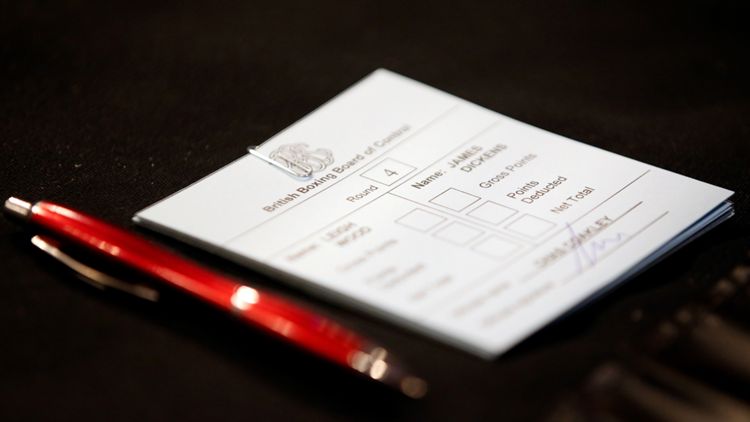Error code: %{errorCode}
How is boxing scored? Points, rules, scores and deductions used by judges and referees
Boxing has always appealed based on the promise of spectacular, dramatic and brutal knockouts.
When a fighter can land a finishing shot or combo on their opponent to the point that they cannot continue, the contest comes to an immediate stop, regardless of how many rounds it was supposed to last.
However, if no knockout occurs and the bell sounds for the final time, how exactly do we decide a winner?
Scoring in boxing is more complex than, say, football, where whoever scores the most goals wins. As a result, it draws a much higher volume of controversy and debate.
If you are looking to figure out how it works, or want to clear up a particular part of the process, you have come to the right place.
Who scores a boxing fight, judges or referee?
In most bouts, three judges are seated at ringside to watch the fight up close.
Those judges are approved by the same body that licences the fights, and when possible, are usually from a neutral location compared to the contestants.
For example, if an American boxer is facing a French boxer, judges from Canada, Britain and Mexico may be preferred.
Similarly, if a small British promoter has two English fighters face off and one is from Hull while the other is from London, perhaps judges from Manchester, Southampton, Cardiff etc.
A three-judge system is mandatory for championship fights. However, if a newly-turned professional is making their debut in a four-round fight, such fights are often judged by one person and one person alone: that will be the bout's appointed referee.
How is the fight scored?
The modern boxing scoring system is known as the '10-Point Must System'. Here is a basic overview of how it works:
- Judges score each round individually, on a 10-point scale. Most rounds are scored 10-9, with the boxer who did better scoring 10 and 'winning' the round, with the other fighter scoring 9.
- If a boxer is knocked down or hurt enough to prompt a standing count from the referee, that fighter loses a point. So, if a boxer dominates a round, controlling and landing better punches throughout and also knocks their opponent down, the end result is a 10-8 round.
- If both fighters score a knockdown in the same round, the deductions 'cancel each other out (so it would probably still be a 10-9 round in favour of the better boxer)
- A judge is able to award a 10-8 round without a knockdown, if the fighter scoring 10 dominated the round by a huge margin (this is usually only used if a round is total one-way traffic, or perhaps if a fighter was saved from a knockdown because the round finished).
- Judges are also able to award a 10-10 round, if the round in their eyes was completely even and there was nothing between the fighters.
 Getty Images
Getty Images
Are 10-10 rounds really allowed in boxing?
Yes! A judge has the right to score a round even, just as they do to score it 10-8 without a knockdown.
Judges are encouraged to avoid it as much as possible, and to only use these scores if they truly feel it's the correct appraisal of that round.
This urging is to ensure they are not overused. The 10-10 round in particular can become too easy a fallback option for judges.
Are points deducted for breaking the rules?
In addition to the above, the referee can instruct all three judges to deduct a point from a fighter in any given round.
They will do so if a fighter has done something to break the rules, such as an intentional foul (low blow, headbutt, or Mike Tyson's favourite, biting an opponent's ear).
A referee can also decide that a fighter has committed accidental fouls far too often than is acceptable, and deduct one point for the repeated offences.
What do boxing judges look for?
Here are the following areas in which boxing judges are encouraged to determine who 'won' or 'lost' a round:
- Effective Aggression: Being aggressive gives the impression of dominance, but unless the boxer is landing shots and not constantly getting countered, it isn't really 'effective'. Judges look for effective aggression, where the aggressor consistently lands punches and avoids those from his opponent.
- Ring Generalship: The fighter who controls the action and enforces their will and style.
- Defense: How well is a boxer slipping, parrying, and blocking punches? Good defense is important.
- Hard and Clean Punches: To the untrained eye, it can appear as if a boxer is landing a lot of shots, when, in fact, most are being blocked or aren’t landing flush. A judge needs to look for hard shots that land clean.
Types of boxing result
If nobody has won via knockout after the scheduled number of rounds, the judges' round-by-round scorecards throughout the fight will determine the winner. With each round being worth a maximum of 10 points, that means a fighter can score as high as 120 in a 12-round fight, 100 in a 10-round fight and so on.
The three judges will each have an overall winner, or perhaps have scored the fight dead even. Here are the various results that can lead to:
- Unanimous decision: All three judges have the same fighter ahead on their scorecards.
- Split decision: Two judges have Boxer A ahead, while one judge has Boxer B ahead. That means Boxer A wins, two scorecards to one.
- Majority decision: Two judges have one fighter ahead, while the third judge scored it as a draw. The winning fighter did not get a unanimous decision, but did take the majority of the cards.
- Draw: If one judge has Boxer A ahead, one judge has Boxer B ahead and the third has scored it as a draw, the overall result is a draw (also known as a 'split draw'). Of course, if all three judges had it dead even, that is also a draw (a 'unanimous draw'). However there is also...
- Majority draw: If two of the three judges have a fight even but the third judge had Boxer A ahead, such a slender edge is not enough for Boxer A to be declared the winner. Instead, it is declared a 'majority draw'.
Sign up to DAZN Ultimate Tier to get PPV's included in your subscription
Subscribe to DAZN's new Ultimate Tier to get a mimuimn of 12 PPV events included per year, on top of another 185 fight nights. Plus Serie A football, watch on multiple devices, and many more extra benefits.
Sign up for £24.99 in the UK / $44.99 in the U.S. More details here.

